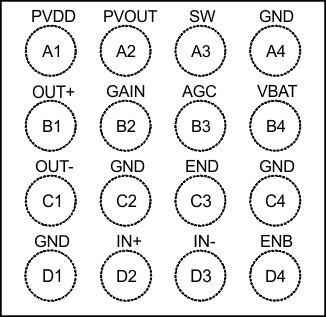ZHCSQQ4C November 2011 – June 2022 TPA2015D1
PRODUCTION DATA
- 1 特性
- 2 应用
- 3 说明
- 4 Revision History
- 5 Device Comparison Table
- 6 Pin Configuration and Functions
- 7 Specifications
- 8 Parameter Measurement Information
-
9 Detailed Description
- 9.1 Overview
- 9.2 Functional Block Diagram
- 9.3 Feature Description
- 9.4 Device Functional Modes
- 10Application and Implementation
- 11Power Supply Recommendations
- 12Layout
- 13Device and Documentation Support
- 14Mechanical, Packaging, and Orderable Information
6 Pin Configuration and Functions
 Figure 6-1 YZH Package16-Pin DSBGATop View
Figure 6-1 YZH Package16-Pin DSBGATop ViewTable 6-1 Pin Functions
| PIN | TYPE(1) | DESCRIPTION | |
|---|---|---|---|
| NAME | NO. | ||
| AGC | B3 | I | Enable and select AGC. |
| ENB | D4 | I | Enable for the boost converter; set to logic high to enable. |
| END | C3 | I | Enable for the Class-D amplifier; set to logic high to enable. |
| GAIN | B2 | I | Gain selection pin. |
| GND | A4, C2, C4, D1 | P | Ground; all ground balls must be connected for proper functionality. |
| IN– | D3 | I | Negative audio input. |
| IN+ | D2 | I | Positive audio input. |
| OUT– | C1 | O | Negative audio output. |
| OUT+ | B1 | O | Positive audio output. |
| PVDD | A1 | I | Class-D power stage supply voltage. |
| PVOUT | A2 | O | Boost converter output. |
| SW | A3 | I | Boost and rectifying switch input. |
| VBAT | B4 | P | Supply voltage. |
(1) I = Input, O = Output, P = Power